Today’s Current Affairs: 21st February 2023 for UPSC IAS exams, State PSC exams, SSC CGL, State SSC, RRB, Railways, Banking Exam & IBPS, etc
Table of Contents
New CEO Of NITI Aayog : BVR Subrahmanyam:
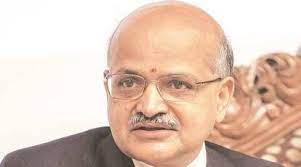
PM Modi appointed BVR Subrahmanyam as the new CEO of NITI Ayog.
- BVR Subrahmanyam served as the Chief Secretary of Jammu and Kashmir.
- He was a 1987 IAS officer from the Chhattisgarh cadre.
- He served as the private secretary of Mr Manmohan Singh during his reign from 2004 to 2008.
The NITI Aayog :
- It serves as the apex public policy think tank of the Government of India, and the nodal agency tasked with catalyzing economic development, and fostering cooperative federalism through the involvement of State Governments of India in the economic policy-making process using a bottom-up approach
- Formed :1 January 2015
- Objectives: Foster involvement and participation in the economic policy-making process by the State Governments of India
- The seven pillars of the NITI Aayog include Pro-activity, Pro-people, Participation, Empowering, Inclusion of all, Equality, and Transparency.
Employee Provident Fund Organization : New Instructions
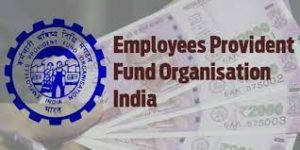
The Employee Provident Fund Organization recently issued new instructions for pensions.
- Earlier the amount contributed towards the scheme was capped at Rs 15,000.
- Now EPFO says the employees can contribute more than this.
- Both employer and employees contribute a certain amount (from their salary) to the EPFO scheme on monthly basis.
- The interest rate of this contributed amount (a part of the contributed amount) is 8.33%.
- When a person retires he gets an accumulative sum.
- Earlier, a sealing was fixed to the contributed amount.
- Now, this limit has been removed.
The Employees Provident Fund Organisation (EPFO):
- It is a statuary body which assists Central Board in administering compulsory contributory Provident Fund Scheme, Pension Scheme and Insurance Scheme for the workforce engaged in the organised sector in India.
First Semiconductor Plant Of India : Gujrat

The Vedanta group and the Foxconn of Taiwan have come together to build the first semiconductor manufacturing unit in Dholera of Gujarat. The companies signed a Memorandum of Understanding with the Gujarat Government
- The semiconductor plant will be built in the Dholera Special Investment Region in Ahmedabad.
- It is a greenfield industrial city.
- The Dholera Special Investment Region Development Authority handles the land and the projects.
- Semiconductor plant manufactures ICs and semiconductor materials.
- The semiconductor materials are made usable for electronic applications through a process called Doping.
- For instance, to create an N-type semiconductor material, one need to add Phosphorous to Germanium.
- Such doping processes are done in semiconductor plants.
India-China Global Growth In 2023 : IMF

The International Monetary Fund recently said that India and China will contribute more than 50% of the global growth in 2023. Another 25% will be contributed by other Asian countries.
- The Asian countries are back to their pre-pandemic growth.
- Especially countries like Cambodia, Malaysia, Vietnam, Thailand, and Indonesia are in full operation
- The inflation will reach the targets set by the central banks of respective countries by the end of 2023.
- In the recent MPC, RBI increased the interest rate and repo rate.
- RBI has increased the repo rate by 250 points in 2022 alone. Still, the inflation is 6.25%, which is higher than the target inflation of 6% set by RBI.
- Central banks need to stay alert. As the Chinese are reopening their economy, inflation may increase
Food and oil processes are coming to stable conditions - Asia is expected to grow by 4.7% in 2023 and by 4.5% in 2024.
- In 2022, the growth rate of Asian countries was 3.8%
India’s First Hybrid Rocket:
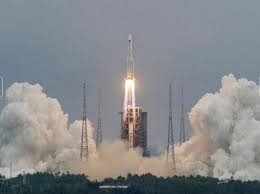
India’s first hybrid-sounding rocket by private players was launched from Tamil Nadu’s Pattipulam.
- Martin Foundation, in association with Dr APJ Abdul Kalam International Foundation and Space Zone India, launched the Dr APJ Abdul Kalam Satellite Launch Vehicle Mission- 2023.
- The selected students designed and constructed a student satellite launch vehicle (rocket) and 150 PICO satellite research experiment cubes that contained different payloads.
- The reusable rocket was made by the selected top 100 students, while the rest made the satellites.
- The rocket can be used for research in weather, atmospheric conditions, and radiation.
- A hybrid-sounding rocket is a type of rocket that uses a hybrid rocket engine to power its flight.
- A hybrid rocket engine uses a solid fuel grain and a liquid or gaseous oxidizer to generate thrust.
- Hybrid-sounding rockets are often used by universities, government agencies, and private companies for scientific research and testing of new technologies because of their low cost
New Breeds Of Indigenous Livestock Species:

The Ceremony for Distribution of Animal Breed Registration Certificates organised by the Indian Council of Agricultural Research (ICAR) was concluded.
- In the address,the Union Agriculture and Farmers Welfare Minister, has emphasised the importance of identifying the large number of indigenous livestock breeds in India to make the agriculture and animal husbandry sector prosperous.
- Animal husbandry has historically been an integral part of agriculture in India and is relevant today as a large section of society is actively engaged and dependent on it.
- India is rich in livestock biodiversity and has developed many specific breeds adapted to various climatic condition
- The livestock sector grew at a CAGR of 7.9% during 2014-15 to 2020- 21 (at constant prices), and its contribution to total agriculture GVA (at constant prices) has increased from 24.3% in 2014-15 to 30.1% in 2020-21.
- Besides their monetary benefit and providing a steady stream of food and revenues for households, livestock provide employment to the rural family, act as insurance during crop failures and the number of livestock owned by a farmer determines the social status among the community.
- Dairy is the single-largest agri commodity in India. It contributes 5% to the national economy and employs 80 million dairy farmers directly.
- Recently, ICAR has registered 10 new breeds of livestock species. This has taken the total number of indigenous breeds to 212 as of January, 2023.
- The ten new breeds of indigenous livestock species are –
- Kathani cattle (Maharashtra), Sanchori cattle (Rajasthan) and Masilum cattle (Meghalaya);
Purnathadi buffalo (Maharashtra) - Sojat goat (Rajasthan), Karauli goat (Rajasthan) and Gujari goat (Rajasthan)
- Banda pig (Jharkhand), Manipuri Black pig (Manipur) and Wak Chambil pig (Meghalaya).
- Kathani cattle (Maharashtra), Sanchori cattle (Rajasthan) and Masilum cattle (Meghalaya);
Underwater Noise Emissions:
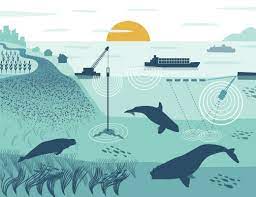
According to a News Study, “Measuring Underwater Noise Levels Radiated by Ships in Indian Waters”, the rising Underwater Noise Emissions (UNE) from ships in the Indian waters are posing a threat to the Marine Ecosystem.
- The measurement of the ambient noise levels was carried out by deploying a hydrophone autonomous system around 30 nautical miles from the Goa coastline.
Highlights of the Study:
- The sound pressure levels of UNE in the Indian waters are 102-115 decibels, relative to one microPascal (dB re 1µ Pa).
- Scientists have agreed to use 1µPa as the reference pressure for underwater sound.
- The East Coast level is slightly higher than that of the West.
- There is an increase by a significant value of about 20 dB re 1µPa.
- Continuous shipping movement is identified to be a major contributor to the increase in the global ocean noise level.
- UNE is posing a threat to the life of mammals like Bottlenose Dolphin, Manatees, Pilot Whale, Seal, and Sperm Whale.
- The main form of energy for multiple behavioural activities of marine mammals, which include mating, communal interaction, feeding, cluster cohesion and foraging, is based on sound.
Draft Reserve Bank Of India (Government Securities Lending) Directions, 2023:

The Reserve Bank of India released Draft Reserve Bank of India (Government Securities Lending) Directions, 2023.
- The RBI proposed introduction of securities lending and borrowing in Government Securities (G-sec) with an aim to facilitate wider participation in the securities lending market by providing investors an avenue to deploy idle securities and enhance portfolio returns.
Draft Norms:
- Government Securities Lending (GSL) transactions shall be undertaken for a minimum period of one day and a maximum of 90 days.
- Government Securities issued by the central government excluding Treasury Bills would be eligible for lending/borrowing under a GSL transaction.
- Government securities issued by the Central government (including Treasury Bills) and the state governments would be eligible for placing as collateral under a GSL transaction.
- An entity eligible to undertake repo transactions in government securities, and any other entity approved by the Reserve Bank would be eligible to participate in GSL transactions as lender of securities.
Government Securities:
- A G-Sec is a tradable instrument issued by the Central Government or the State Governments.
- A G-Sec is a type of debt instrument issued by the government to borrow money from the public to finance its Fiscal Deficit.
Harike Wetland:
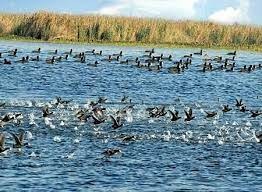
According to the recent water bird census, the Harike wetland witnessed a decline in migratory birds’ arrival this year.
- Harike wetland Sanctuary also locally known as “Hari-ke-Pattan” is one of the largest wetlands in northern India.
- It is situated at the confluence of two major rivers of Punjab Sutlej and Beas.
- Harike wetland came into existence in 1953 due to the construction of a barrage on River Sutlej.
- It has been designated as one of the Ramsar sites in India.
- This is a man-made, riverine wetland spreads across three districts of Punjab e., Tarn Taran, Ferozepur and Kapurthala.
Momentum 2.0 App:

Delhi Metro will introduce the Momentum 2.0 app that will allow users to make a variety of purchases and schedule various services, including those for last-mile connectivity.
- Momentum 2.0 app is India’s first virtual shopping app for the metro.
- It is launched by the Delhi Metro Rail Corporation (DMRC).
- It will allow customers to make payments and schedule services, including those for last-mile connections.
- It will also contain features such as rapid recharge of Delhi Metro’s smart cards and smart payment choices for other utility services.
- The app would also allow users to have digital lockers at metro stations.
- Commuters can use this app to find bikes, e-rickshaws, cabs, and the schedules of feeder buses and cluster bus routes from Delhi Metro stations.
- The app will also provide complete information on metro station infrastructure, such as the location and condition of gates, lifts, escalators, platforms, train scheduling, coach occupancy, and space availability.
- The app will also provide information on shops, outlets, kiosks, and ATMs located at the stations.




